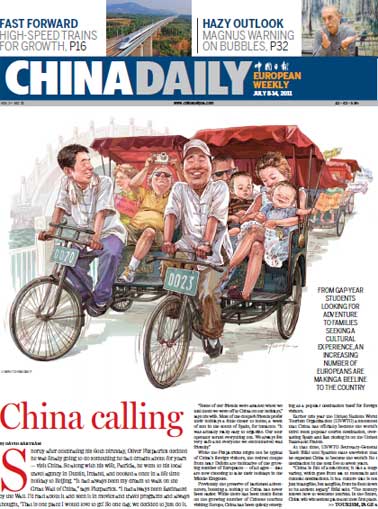Travel pioneer who helped open China to the world
Updated: 2011-07-08 10:47
By David Bartram (China Daily European Weekly)
Regardless of this, Morrell found that many of the early travelers from Europe were older, retired professionals. It was only when the tours became somewhat more established that younger people became more prevalent, especially teachers traveling during holidays. These new tourists enjoyed greater freedom than the earliest travelers, but still encountered limited infrastructure.
"At the very beginning in the very late 1970s there were only a handful of cities open to foreign visitors, but that gradually increased. They also introduced a system of foreign exchange certificates. It was mainly used as a kind of tracking device to measure how much overseas income they were making, but you couldn't get renminbi overseas and you had to give it all back before you left."
|
 Elizabeth Morrell has run tours to China for more than 30 years. [Provided to China Daily]
|
Tourists still visited China's most famous sites back then, but found that popular sightseeing locations such as the Great Wall were very different to the slick moneymaking operation in place today.
"Places like the Great Wall were not particularly developed back then. At the very beginning you couldn't even buy a postcard and there were no restaurants on site. There was very little infrastructure in general, certainly no luxury hotels and cable cars like you see by the Wall today."
To aid her clients, Morrell began to write one of the first modern tour guides of China in the early 1980s. Published in 1984, the Visitor's Guide to China was an attempt to not only discuss the culture, history and geography of China, but also provide a survey of its hotels, restaurants and attractions.
"I wrote the guide book from our direct experience of seeing that people really didn't know much about China at all. The books that were available were quite out of date by the 1980s and a lot of the information predated the 'cultural revolution' (1966-76). We wanted to bring out something that was more current, but while I was writing the book more and more places kept opening up, so I had to keep expanding it."
Fast forward 30 years and the landscape of international travel to China could hardly have changed more dramatically. But Morrell still offers tours to the country through her new tour operator, Benmo, which focuses on providing tailor-made trips that go beyond the standard tourist hotspots.
"I still like traveling to China. Every time there are new things to discover. Recently I spent a couple of weeks in Anhui and Fujian provinces looking at ancient kiln sites and architecture. A lot of our tours are tailor-made for special interests. We try to take people to places not many go, so, for example, we take people interested in porcelain to the old kiln sites."
Morrell can reflect upon her role in creating a tourist industry in China now worth 1.55 trillion yuan (166 billion euros) a year and still growing. Nowadays a range of people far beyond those early visitors are choosing to take their holidays in China.
"I think there is a wider range of people booking holidays to China. The average age is still quite high but has come down. There are many more people in their 40s or 50s who have time and money. At the other end of the market there are the backpackers. There were no backpackers in those early days, which didn't really develop until the 1990s."
But with growing numbers comes the danger that tourists are no longer enjoying an authentic "Chinese" experience. With Western fast-food restaurants now a common sight in every Chinese city, Morrell appreciates you have to dig a little deeper to find the real China.
"If you are a business person you can stay in the Marriott hotel and be totally cocooned from Chinese life. But if you go with us we'll try and get behind the scenes a bit. I think we like to show people that you can still find the old China. You can still have a very Chinese experience. You can be very comfortable but you can find real China as well."
E-paper

Shining through
Chinese fireworks overcome cloudy times, pin hopes on burgeoning domestic demand
Carriers plan new routes to boost linkages
Pen mightier than the sword
Stroke of luck
Specials

90th anniversary of the CPC
The Party has been leading the country and people to prosperity.

My China story
Foreign readers are invited to share your China stories.

Green makeover
Cleanup of Xi'an wasteland pays off for ancient city
